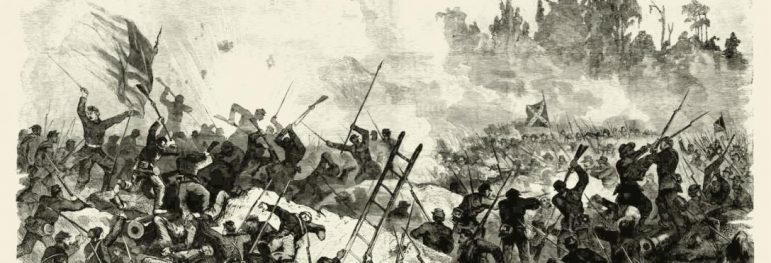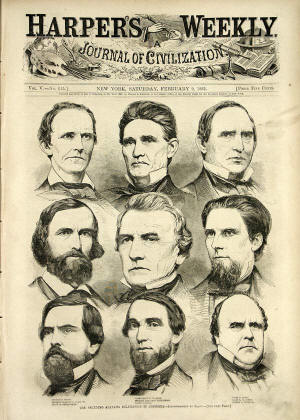Alabama Civil War

Alabama Civil War Index
Prologue
Alabama Secedes

Alabama passed its Ordinance of Secession on January 11, 1861, joining South Carolina and Mississippi who had seceded days earlier. Harper’s Weekly carried the story inn its February 9, 1861 edition which featured a front page sketch of “The Seceding Alabama Delegation in Congress” which was make from a photograph by Mathew Brady.
Alabama passed its Ordinance of Secession on January 11, 1861, joining South Carolina and Mississippi who had seceded days earlier. Harper’s Weekly carried the story inn its February 9, 1861 edition which featured a front page sketch of “The Seceding Alabama Delegation in Congress” which was make from a photograph by Mathew Brady.
Alabama was removed from much of the major Civil War military activity due to its location. Alabama did however become a desired target due to it serving as a host for the Confederate States of America.
Alabama’s iron industry and seaports on the Gulf Coast remained serious problems for the US and provided the setting for one of nation’s most famous naval engagements, The Battle of Mobile Bay.
Alabama Civil War Soldiers
Alabama soldiers fought in hundreds of battles; the state’s losses at Gettysburg were 1,750 dead plus even more captured or wounded; the famed “Alabama Brigade” took 781 casualties. Governor Lewis E. Parsons in July 1861 made a preliminary estimate of losses. Nearly all the white men served, some 122,000 he said, of whom 35,000 died in the war and another 30,000 were seriously disabled. The next year Governor Robert M. Patton estimated that 20,000 veterans had returned home permanently disabled, and there were 20,000 widows and 60,000 orphans. With cotton prices low, the value of farms shrank, from $176 million in 1860 to only $64 million in 1870. The livestock supply shrank too, as the number of horses fell from 127,000 to 80,000, and mules 111,000 to 76.000. The overall population remained the same—the growth that might have been expected neutralized by death and emigration.
-
Alabama Brigade
-
4th Alabama Infantry Regiment
-
1st Alabama Regiment Cavalry
-
15th Alabama Infantry Regiment
was organized in the summer of 1861 at Fort Mitchell, Alabama. After being sent immediately to Virginia, it was placed in a brigade under General George B. Crittenden and fought in many battles including the First Battle of Cold Harbor, Front Royal, the Second Manassas, and Harper’s Ferry. When it was put into the Alabama Brigade on 19 January 1863, it was under the command of William C. Oates, who after the war became the Governor of Alabama. Alexander Lowther later replaced Oates as commander in 1864.
-
44th Alabama Infantry Regiment
The 44th Alabama Infantry Regiment was created in Selma, Alabama, under Colonel James Kent in 1862. Kent resigned 1 September 1862, leaving the regiment under William Perry’s command. The 44th fought in battles such as the Second Manassas, Harper’s Ferry, and Sharpsburg. This regiment was severely decimated at Sharpsburg on 17 September 1862, where almost 47% of the regiment sustained casualties. It was added to the Alabama brigade, which then comprised the 4th Alabama infantry regiment, two months later in November 1862. Over the course of the war, 1094 men had been in this regiment at some point but only 209 survived to surrender at Appomattox.
-
47th Alabama Infantry Regiment
The 47th Alabama Infantry regiment was assembled at Loachapoka, Alabama, on 22 May 1862 under Colonel James McCarthy Oliver. When it travelled to Virginia it was placed into General Taliaferro’s brigade. This regiment lost many men in numerous battles such as Cedar Run, the Second Manassas, and Harper’s Ferry. Oliver resigned 11 August 1862 and was replaced by James W. Jackson, who was promoted to Colonel. After being decimated at Sharpsburg on 17 September 1862 and again at Fredericksburg on 13 December 1862, it was transferred into the Alabama Brigade in January 1863.
-
48th Alabama Infantry Regiment
The 48th Alabama Infantry Regiment was started in Auburn, Alabama, and put under General William B. Taliaferro’s brigade along with the 47th regiment. The first commander of the regiment was Col. James Lawrence Sheffield, who resigned in the fall of 1864. Captain John W. Wiggington, who had been promoted to the rank of Major in the fall of 1864, was the commander of the 48th at their surrender at Appomattox.[9] During the war, it fought at battles such as Cedar Run, the Second Manassas, and Sharpsburg. It was decimated at Fredericksburg, which was fought 11–15 December 1862. Along with the 47th Alabama Infantry Regiment, it was placed into the Alabama Brigade in January 1863.
Alabama Civil War Timeline
March 22, 1865
Alabama Civil War Battle Sites
-
-
Battle of Athens
-
Battle of Day’s Gap
-
Battle of Crooked Creek
-
Battle of Decatur
-
Battle of Fort Blakely
-
Battle of Mobile Bay
-
Battle of Newton
-
Battle of Ebenezer Church
The Battle of Ebenezer Church, which took place on April 1, 1865, was an engagement in the American Civil War (1861-1865). Near Ebenezer Church in present-day Stanton, Chilton County (Bibb County at the time).
-
Battle of Selma
-
Battle of Munford
-
Battle of Sulphur Creek Trestle
-
Battle of Spanish Fort
-
Siege of Bridgeport
-
Battle of Cherokee Station
-
Skirmish at Paint Rock Bride
-
Streight’s Raid
-
Wilson’s Raid
-
Alabama Civil War Monuments
Alabama Civil War Support Sites
Selma Munitions Plants
The Selma Arsenal
Selma Naval Ordnance Works
Confederate Naval Yard
Confederate Nitre Works
Alabama Civil War Museums
Alabama Civil War Sites Map
Alabama Civil War Records
Alabama Civil War Hospitals
In Memory of:
John Daniel Platt
37th Infantry Regiment was organized during the spring of 1862 with men recruited in the counties of Clarke, Lowndes, Greene, De Soto, Jasper, and Claiborne. After participating in numerous battles in Mississippi the unit was assigned to General Hebert’s Brigade in the Department of Mississippi and East Louisiana. It was captured when Vicksburg fell and during the siege it lost 17 killed, 56 wounded, and 7 missing. Exchanged, the regiment contained 26 officers and 442 men in December, 1863. It then served under Generals Mackall, Cantey, and Featherston in the Army of Tennessee. The 37th fought in the Atlanta Campaign, endured Hood’s winter operations in Tennessee, and ended the war in North Carolina. It reported 5 killed and 27 wounded of the 453 engaged at Iuka, had 19 killed and 62 wounded at Corinth, and sustained 81 casualties at Hatchie’s Bridge. Many were disabled in Tennessee, and early in 1865 its ten companies were reduced to three and the unit was redesignated the 37th Battalion. It surrendered in April. The field officers were Colonels Orlando S. Holland and Robert McLain; Lieutenant Colonels William S. Patton, Samuel H. Terral, and William W. Wier; and Major John McGee.SOLDIERS:
